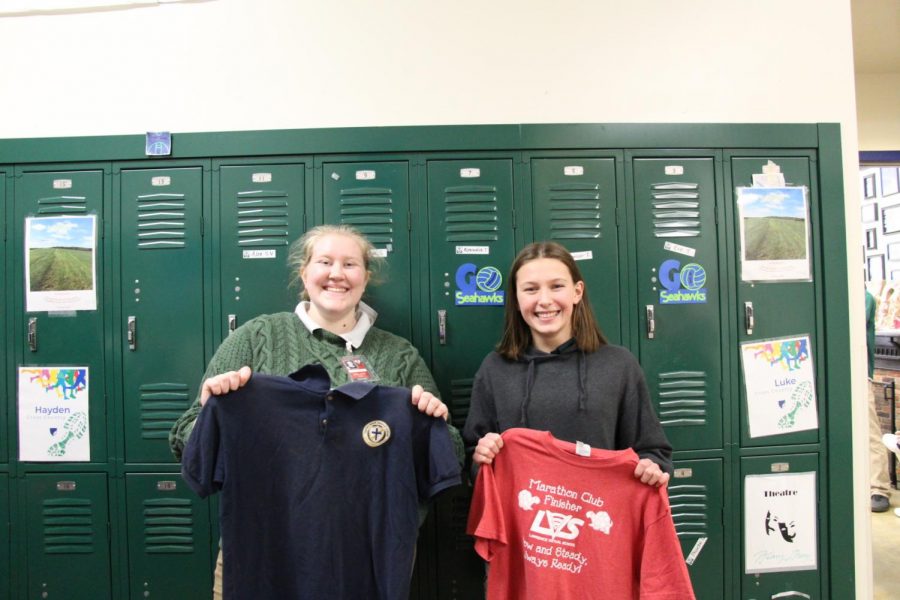Bishop Pre-bury
Senior Emma Silvestri and eighth grader Ellie Berkland hold shirts from their old schools. Similar to Seabury, Silvestri had to wear a uniform to school every day.
February 20, 2020
Bishop Seabury has yet to add a kindergarten class. As a result, all of its students have been forced to attend other schools prior to Seabury. From public to private schools, or even homeschooling, students often experience marked differences at Seabury based on their school backgrounds, from homework to friends to leisure time.
“There were a lot of people, you had a lot less one on one time and the friendships weren’t as great,” says eighth grader Evan Maletsky of his experience at public school as compared to Seabury. Maletsky attended Cordley Elementary School before coming to Seabury in sixth grade. “It’s a lot nicer here [at Seabury],” he says.
Freshman Grey Werner attended West Middle school before transferring to Seabury this year. He generally agrees with Maletsky on the greatest difference between public school and Seabury, which is “The size. I went from a class of almost 200 people to a class of 35 . . . [it] was a big change.” Overall, his experience at West was “Very long . . . I’m just going to leave it at that,” says Werner.
Senior Emma Silvestri, unlike Grey and Maletsky, attended Corpus Christi, a private Catholic school, before switching to Seabury for sixth grade. For Silvestri, the predominance of Catholicism at Corpus Christi is the greatest difference between the schools. “[Corpus Christi] is a Catholic school, and a lot of it was based on religion . . . It’s not so much here, and I really like that about Seabury,” she says. “We’re an Episcopal school, but that’s not all we are. Corpus is a Catholic school, and that’s sort of all they are, in my opinion.”
Although public and private school experiences differ, some Seabury students had an entirely separate experience in the comfort of their own homes. Eighth grader Ellie Berkland is one of the few homeschoolers at Seabury. “I liked [homeschool] a lot because you could sleep in, and you only had to do school for a few hours a day, and there was no homework at night,” she says. “I’ve become a lot more social [at Seabury].”
Maletsky believes sixth grade at Seabury helped him transition from Cordley, particularly in preparing for the homework. “It introduced us to the community and all that . . . I think I was pretty prepared going into seventh grade. If they had given us a lot of homework in sixth grade, I wouldn’t have been prepared at all,” he says.
“Sixth grade is really an important year, and we try to get everybody on the same page and get them ready for Seabury,” agrees Admissions Director and faculty member Leslie McCaffrey. Because of her job, McCaffrey is in a prime spot to observe students’ transitions from their prior schools into Seabury. “Kids come from all kinds of schools—public school, Prairie Moon, Century school, homeschool—so some kids come here, and they’ve been taking state assessments all the time. Other kids come here and they’ve never even taken a quiz or a test,” she says.
“It was definitely a big jump for me academically, coming here . . . I never finished reading the Harry Potter series, because I started them in fifth grade then I came to sixth grade, and I didn’t have time to read anymore,” says Silvestri. Most students interviewed, regardless of the school they attended before, found Seabury’s level of homework more intense.
“I have more homework, so trying to do that and still balancing sports,” says Berkland of what was most difficult to adjust to when she switched to Seabury. Although keeping up with sports and schoolwork has been a challenge for Berkland, activities helped her adjust socially at Seabury. “I was able to find friends right away because of sports and being able to meet other people,” she says.
Interestingly, public middle school helped ease Werner’s introduction to fast-paced Seabury academics. “You have to be organized at public school, because of how many people there are, and you have to keep track of your stuff, so that made it easier to transition to Seabury,” he says.
Regardless of school backgrounds, McCaffrey believes most transfer students become a part of Seabury within a few short months. “Thanksgiving is about the time it takes for everybody to just sort of catch up and get it figured out, so I think it only takes kids a couple months until they are just in the flow of Seabury life,” she says.
Despite varying school experiences with homework, religion, size and leisure time, we are all a part of Seabury. As Silvestri says, “It’s always different coming into a new school and meeting new people, . . . but a few months in I already had found close friends.”
